Some of the teams in Serie A have been incredibly efficient in their attacking actions in the 2019/20 season. Many of them are willing to dive into forward ventures and focus their actions on their performance in the final third.
While being over-productive upfront came as a surprise from some of them, it turns out that others experience difficulties to convert their chances into goals. Napoli are one of the teams that seem to underperform comparing their end product to their actions in the final third.
The Blues went through a managerial change and are currently positioned sixth in the league. Their new manager Gennaro Gattuso managed to keep them up and running, but it seems that something is missing in their approach.
The data analysis shows that they are among the most active teams in the opposition half, but yet their goal record of 41 scored goals doesn’t prove that and can be compared to some of the mid-table teams’. Is the fault in their delivery methods or is it their finishing that decreases their efficiency?
In this tactical analysis in the form of scout report, we will break down their attacking strategy using analysis and data. We aim to look into their tactics and see what might be the reason for them to underperform in the final third.
Player rotations and attacking style
Napoli have a quite clear attacking strategy, which works for the most part. They use all channels to build their attacks through, although the tendency shows that they prefer the flanks rather than the middle, playing most frequently in 4-4-3 and occasionally 4-4-2 formations.
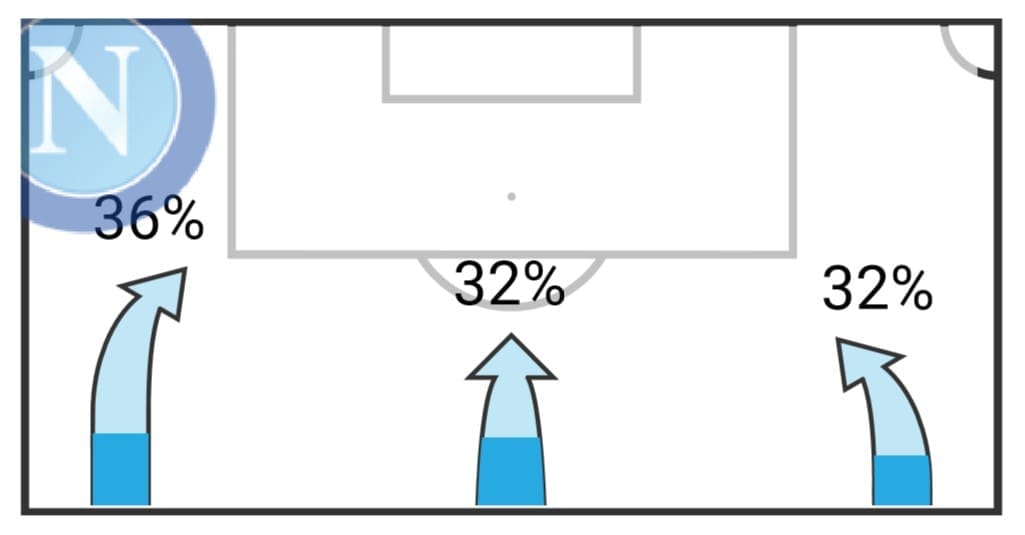
That’s because the team rely a lot on their crossing attempts. Their structure is pretty compact, with a high defensive line and attackers, who drop deep to the edge of the final third in order to help to advance the ball.
They use player rotations on the flanks, especially due to the active role of their full-backs who help with exploiting the wide areas and crossing, allowing the wingers to occupy the half-spaces and have more freedom.
The connection between the full-backs and the wingers is proven by looking into Napoli’s most frequent passing links in their games. It turns out that the wide players are most frequently on top positions when it comes to pass combinations. That is, of course, a result of the team’s attacking patterns.
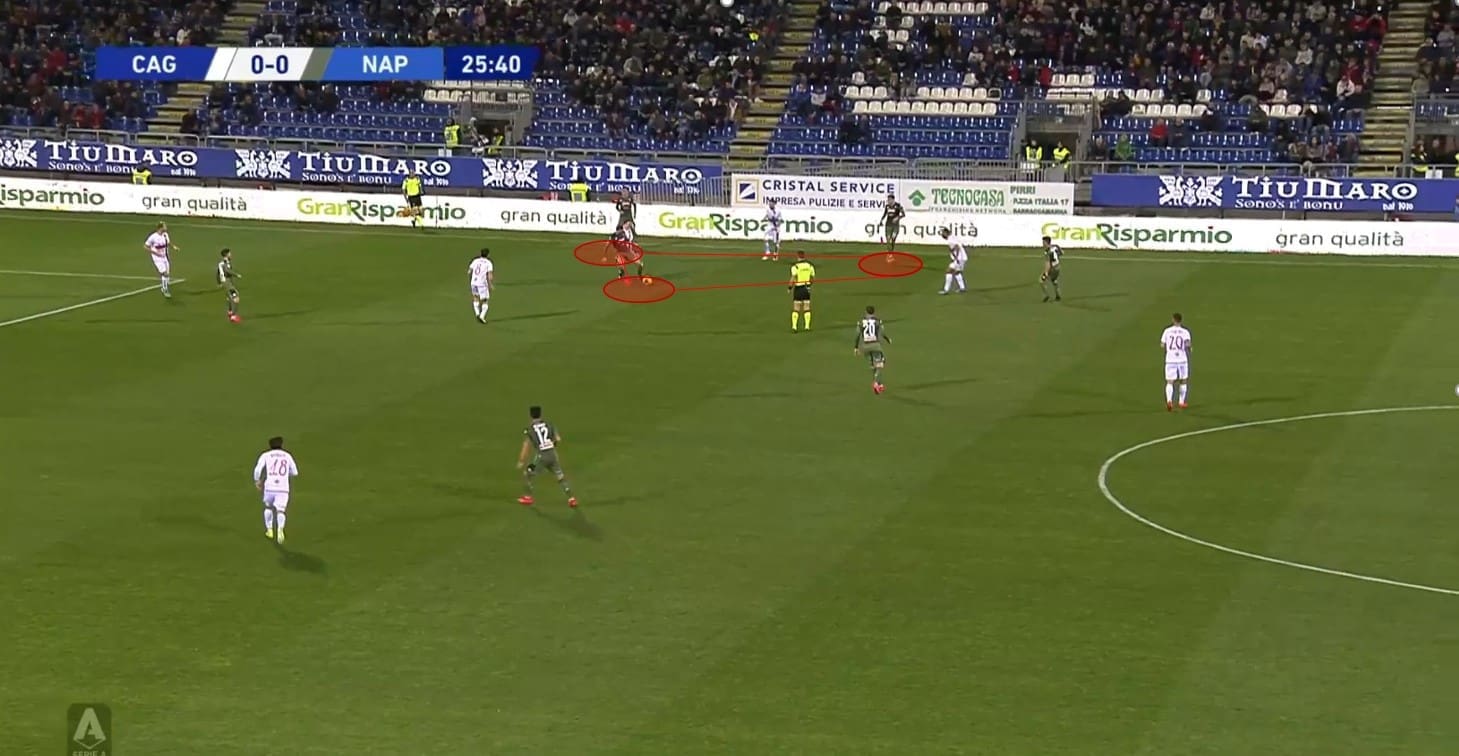
Exploiting the flanks doesn’t mean that Napoli neglect the central areas though. Whenever the opposition is pressing intensely and is blocking the passing lanes in the wide areas, the full-backs tend to send the ball centrally, where talented players like Fabián Ruiz use their technical abilities and movement to deliver it further. All that results in creating 36.62 positional attacks per game.
The team often relies on quick movement and overloading the final third. While the forward players stay deeper back, often in the same line as the central midfielders, they start moving off the ball immediately after the ball-carrier reaches the more advanced areas. That’s where more rotations appear, due to the active attacking contribution of the midfielders. This allows them more options in front of the goal as well as helps in dragging players out of position and freeing up space.
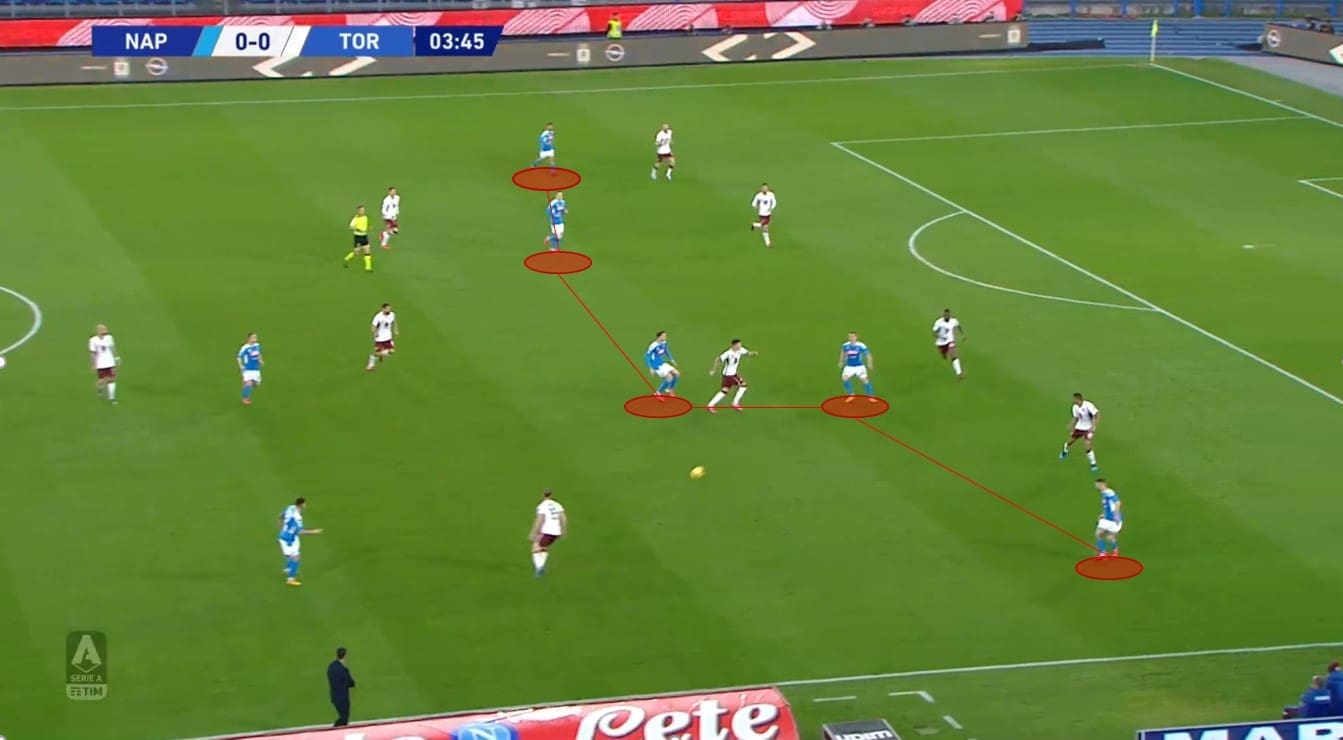
Final third delivery
In this section, we are going to take a look at their ball delivery methods. Before blaming the strikers’ finishing skills, we need to analyse the quality of the balls they receive. That means looking into the different passes, their success rate and also the areas they end up in.
Including data for Napoli’s positioning in the league in the different indicators will help us to see if their performance is sustainable and their statistics show their performance realistically. We’re going to analyse the following topics: passes to the final third; passes to the box; crosses; set-pieces (corners) and counter-attacking efforts.
1. Passes to the final third
Napoli are the Serie A leaders when it comes to passes to the final third, not only looking at their frequency per 90 minutes but also their accuracy. The team sends 72.31 passes to the final third on average with 80.4% of them being successfully delivered. That is a result of their strategy to use short pass combinations to build-up.
It is not a surprise that they send a high number of passes to the final third due to their highly positioned defensive line. They aim is to spend more time in the opposition half and reduce the space between the lines, that’s why many of their passes end up in the more advanced areas. They often come from the defensive line and part of the reason their accuracy rate is so high is that their opponents are often pinned back in defence and don’t apply pressure to the ball carrier.
The team’s positioning is not the only reason for their high pass frequency. When their opponents do apply pressure Napoli are often forced to send the ball back and involve more players, but due to their attack-minded approach, they always aim to get it further as quickly as possible. This results in moving the ball back and forth which increases the pass frequency.
When pressured, the delivery areas are not always perfectly measured in order to continue the attack, but having more players committed to the forward actions, helps a lot in retaining possession and actually escaping the pressure.
Although they often use the wide players for that, the key man when it comes to distributing the ball to the more advanced areas is Ruiz. The pivot has a huge role in their actions and leads the Serie A player rankings when it comes to passes to the final third per 90. He delivers the ball 12.13 times on average and he considers the areas where he sends it to well enough for his teammates to be able to continue the attack properly. The team’s attacking actions are also frequently supported by Piotr Zieliński although his decision-making on the ball receiver could take some improvements. He sometimes only thinks about advancing the ball, rather than delivering it to areas where they could sustain pressure and actually hold on to it.
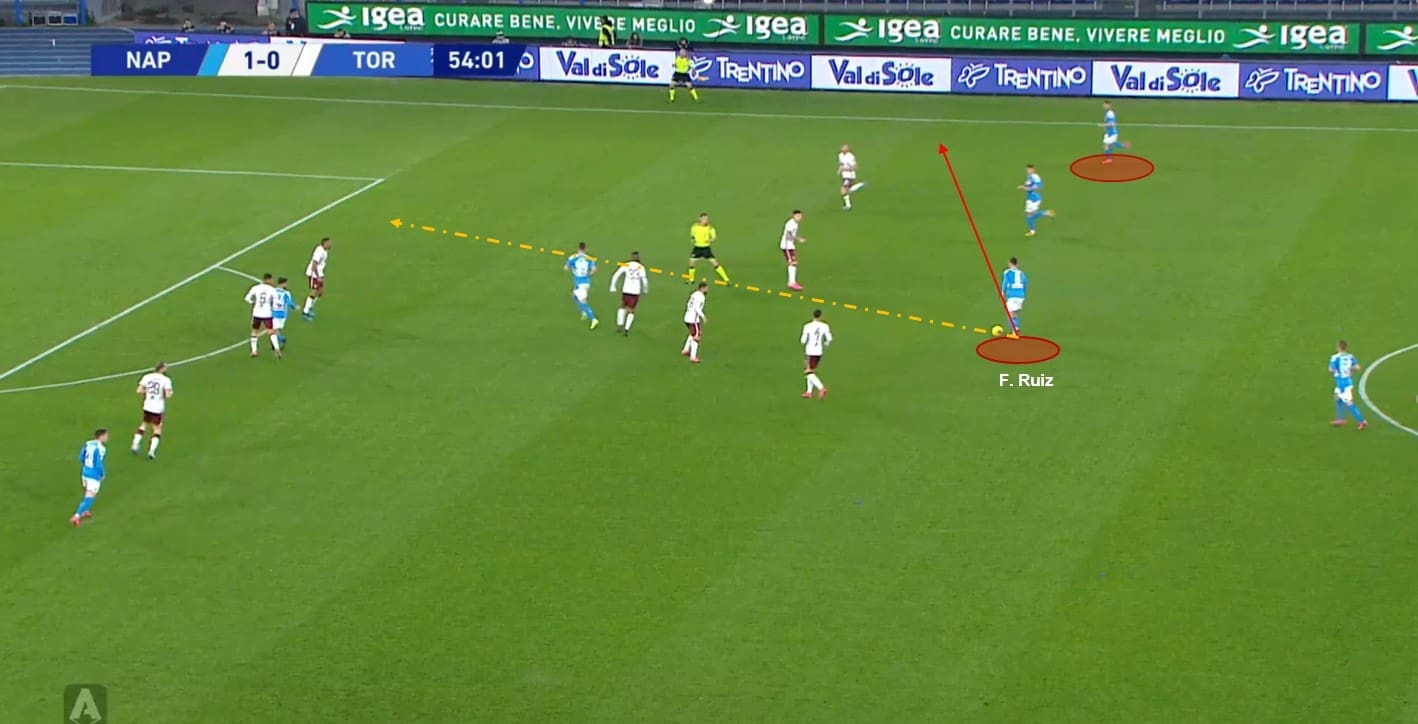
2. Passes to the box
The data shows that Napoli are among the most creative sides in the league this season as per their through balls, key passes and smart passes rates. In all of these areas, they have ranked in the top three positions. The team’s overloading in the advanced areas gives them more options and allows them to be creative, resulting in 4.36 key passes per 90 and a tremendous amount of 9.48 through balls per game.
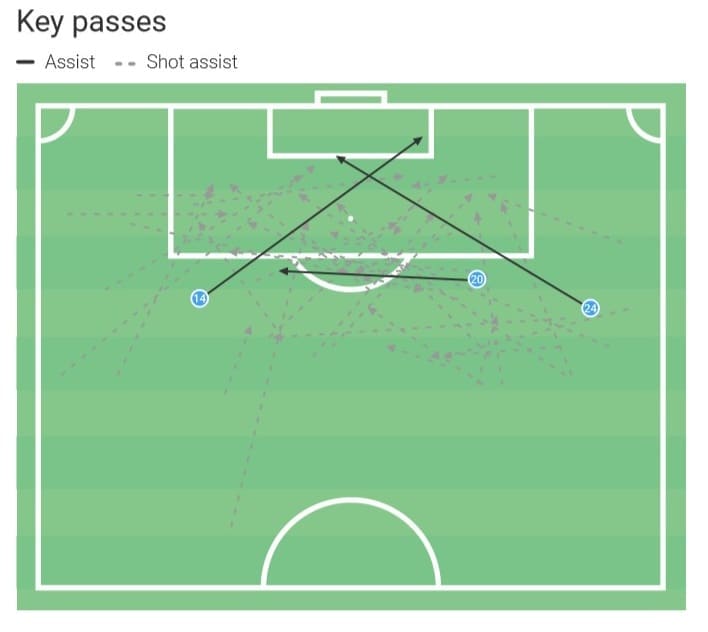
Lorenzo Insigne is the leading figure when it comes to creating opportunities for his teammates. His spatial awareness and flair for a good pass result in 2.2 through balls on average. His position though affects the delivery areas. Due to his wide role, it is often difficult for his teammates to take proper actions after receiving the ball because he delivers it to areas with quite difficult angles for shooting and even though his teammates are alone against the goalkeeper this decreases their shot success rate.
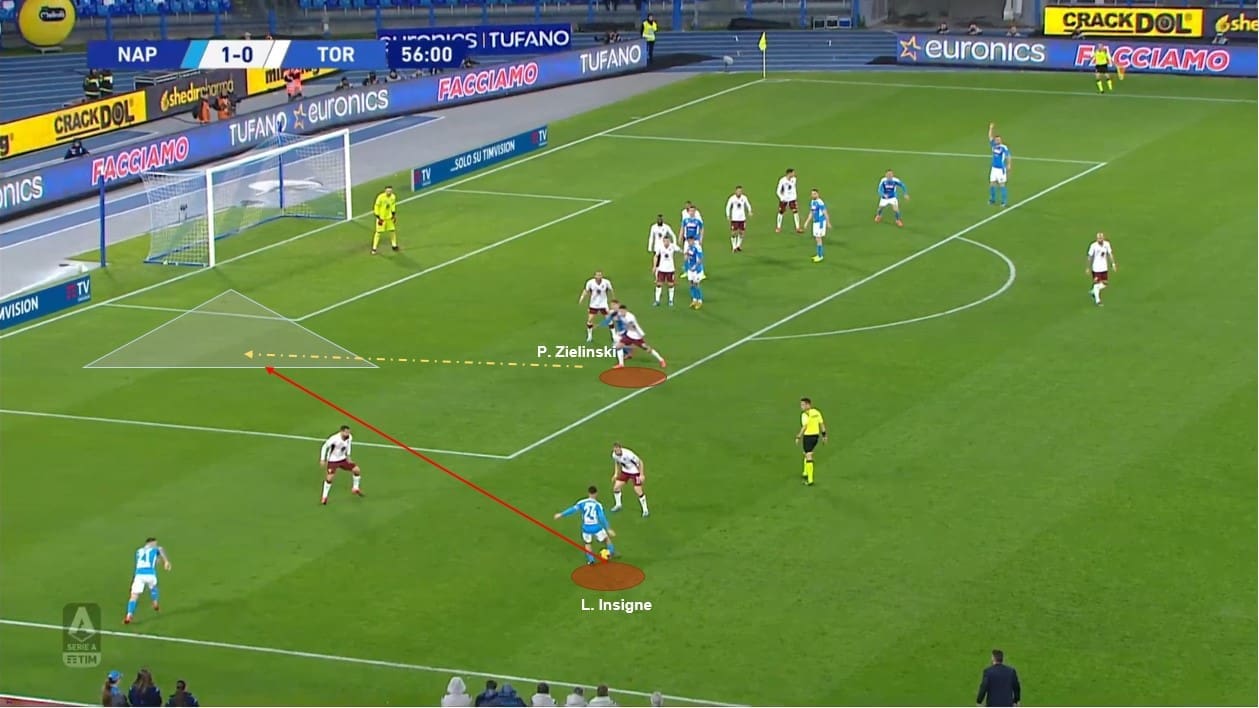
Zieliński also supplies the frontline with through balls, but they are often too long and impossible for his teammates to reach, letting them go to waste. Dries Mertens also contributes despite his role in the front line. Apart from being a direct threat, he also supports with passes due to frequent movement back, especially when Arkadiusz Milik plays upfront. He often makes steps back and tries to combine with his fellow attackers, supplying them with good balls.
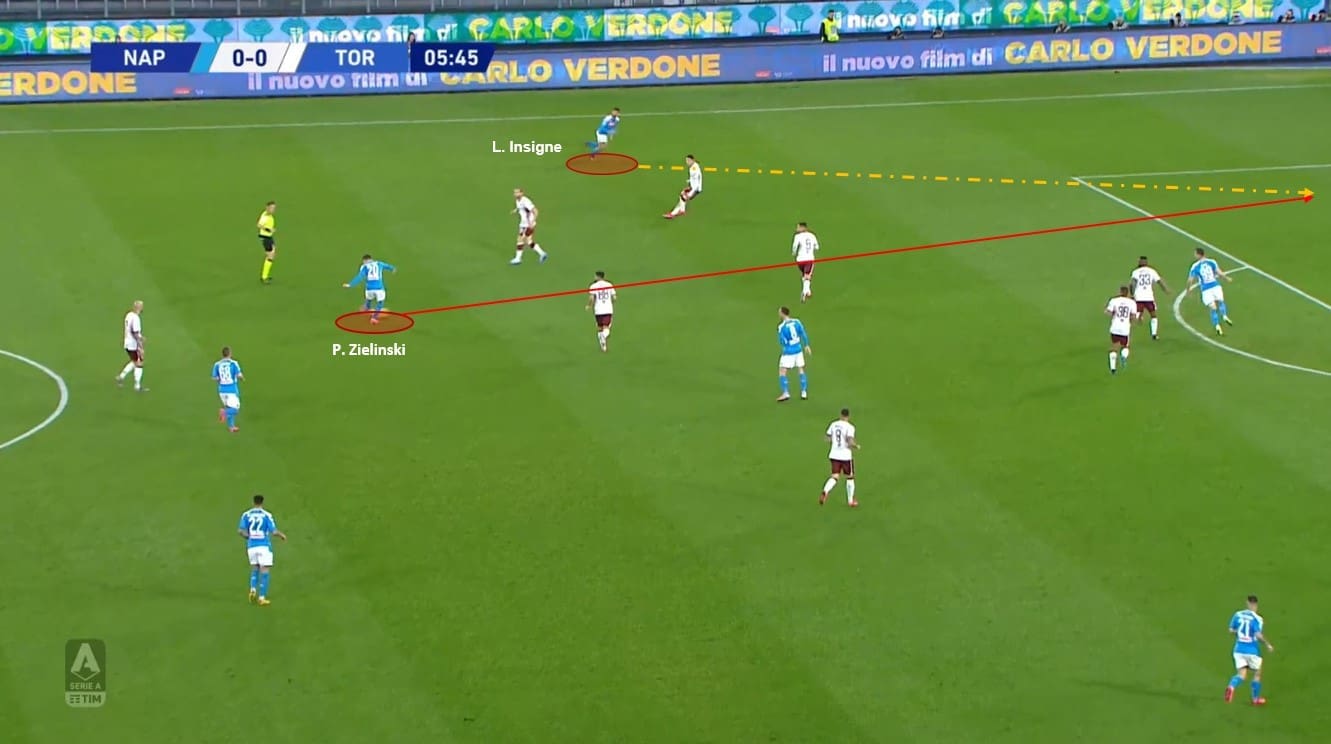
The lack of precision and the delivery areas have an impact on the team’s accuracy. That’s why Napoli might be first in through balls per 90 minutes, but their accuracy rate is significantly lower compared to the other teams’.
The team’s long ball efforts are also worth a mention. Although the Blues don’t rely on them as often as most of the other teams, they do have a long ball strategy that includes delivering the ball to the advanced areas. It involves Milik as a passing outlet. He would free himself by dropping deeper and his teammates would send long balls to him, expecting him to use his physicality and aerial abilities to take on his markers. Meanwhile, the wingers would move off the ball providing some more options for finishing the attack.
3. Crosses
As mentioned Napoli use crossing as a delivery method quite often. They send 20.62 crosses on average, placing them first in the league in that indicator per 90 minutes. As it is with their through balls though, their accuracy is not meeting the expectations, making it harder for the receivers to take actions towards the goal after that.
As it could be seen by their average crossing map below from their last five games, only a few of their high number of crosses actually reached their destination. In this case, the delivery areas seem good, hence they send the ball to key areas, good for shooting, but their accuracy is low and finding the attackers turns out difficult. We’ll look into the front players’ movement later in the analysis and see if their off the ball abilities are affecting the crosses’ outcome.
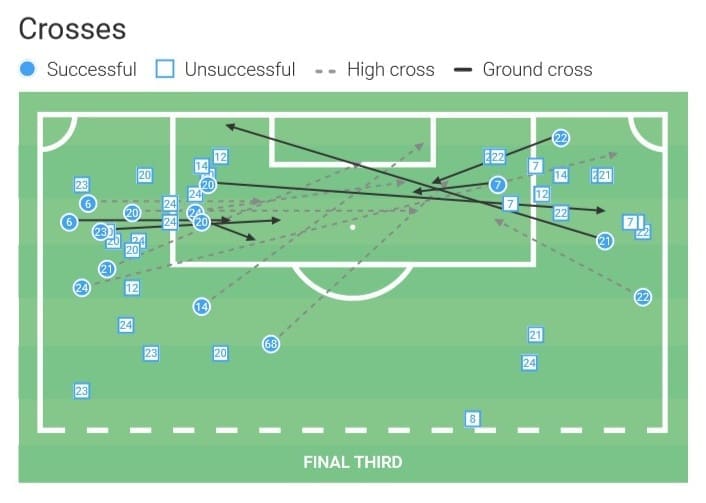
José Callejón is crucial when it comes to the team’s crossing efforts. He sends 4.74 crosses on average and is always willing to deliver the ball to the box. His positioning during the team’s build-up is key for supporting the attacking actions. The Spaniard has assisted for six goals this term and all of them were crossing efforts. He often contributes with key passes in the same manner, but his fellow attackers fail in converting them into goals.
He prefers going deeper in the opposition half and then directly sending the ball to the box. He also frequently sends the ball to the far side of the box, instead of the closest to him and that’s when his teammates manage to sneak behind the defenders who are drawn to the ball carrier. For his efforts to be successful the team needs to move smoothly together and all the players should have strong spatial awareness.
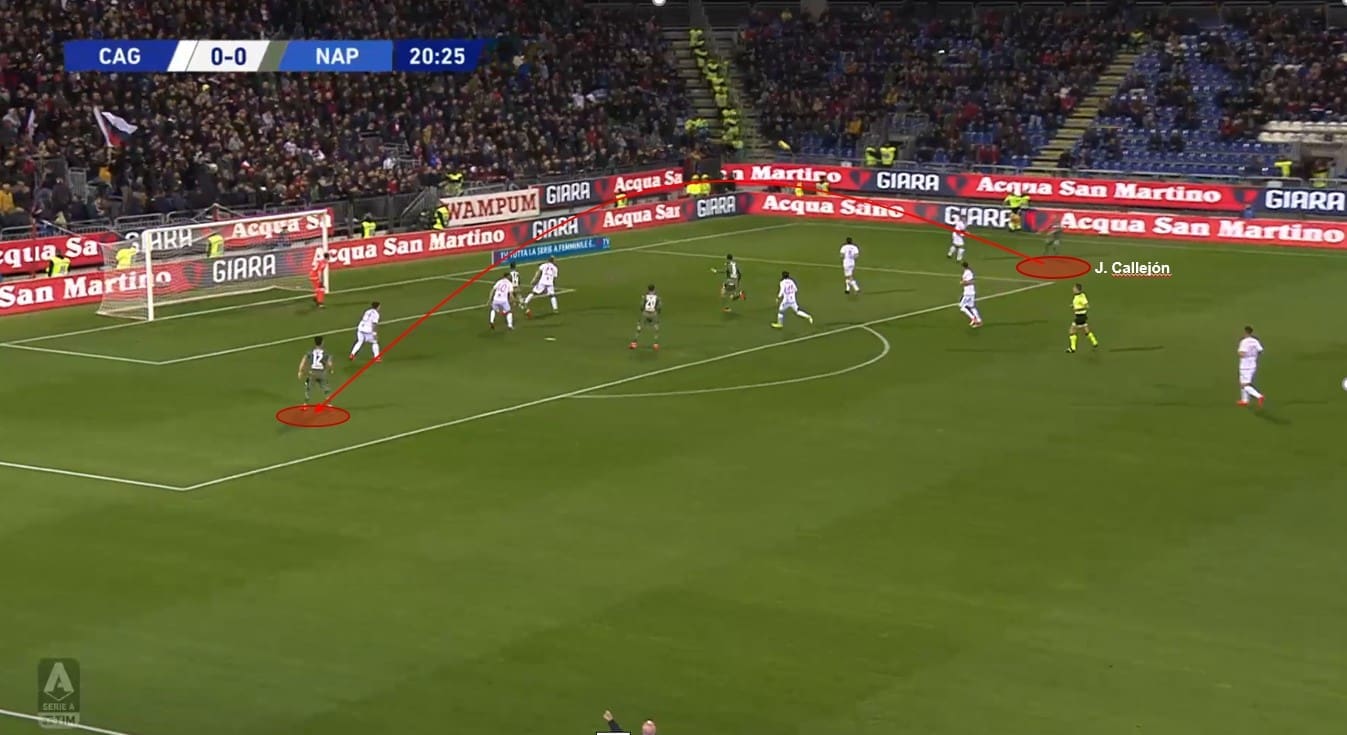
The full-back Mario Rui is the main responsible for crossing from the left. That’s the side that Napoli use most frequently for creating their attacks where his partnership with the wingers is crucial. He often provides the ball directly to the goalkeeper area, which sounds good, but it actually limits the forwards’ space for movement and actions.
4. Set-pieces
Napoli often have set-piece opportunities and have managed to score seven goals that way. They take 6.08 corners per game on average but hardly manage to take advantage of any of these chances. Their most frequent target area is the goalkeeper zone, which often doesn’t give the attackers the needed space to take on him and score. An average of two of their corners turn into shots, but usually many players are committed to covering these areas.
Napoli also very smartly use attacking throw-ins. They use off the ball movement to drag players and free up some space and use short pass combination to reach the box quickly.
5. Counters
When counter-attacking the team relies on pace and committing more players upfront. There are usually three and more players that get involved in the counters both on and off the ball. Napoli try to get as many players as possible to the final third in a short period of time for a couple of reasons – increasing their chances to score by simply having more options in front of the goal, but also for overloading the area and dragging the defenders out of position. They successfully create 3.35 counters per 90 minutes and end up with shots rather often.
The main point here is actually how many of these shots turn into goals. The answer is, none. The Blues haven’t scored even once on a counter and the reason behind this is often their hasty actions and poor work under pressure.
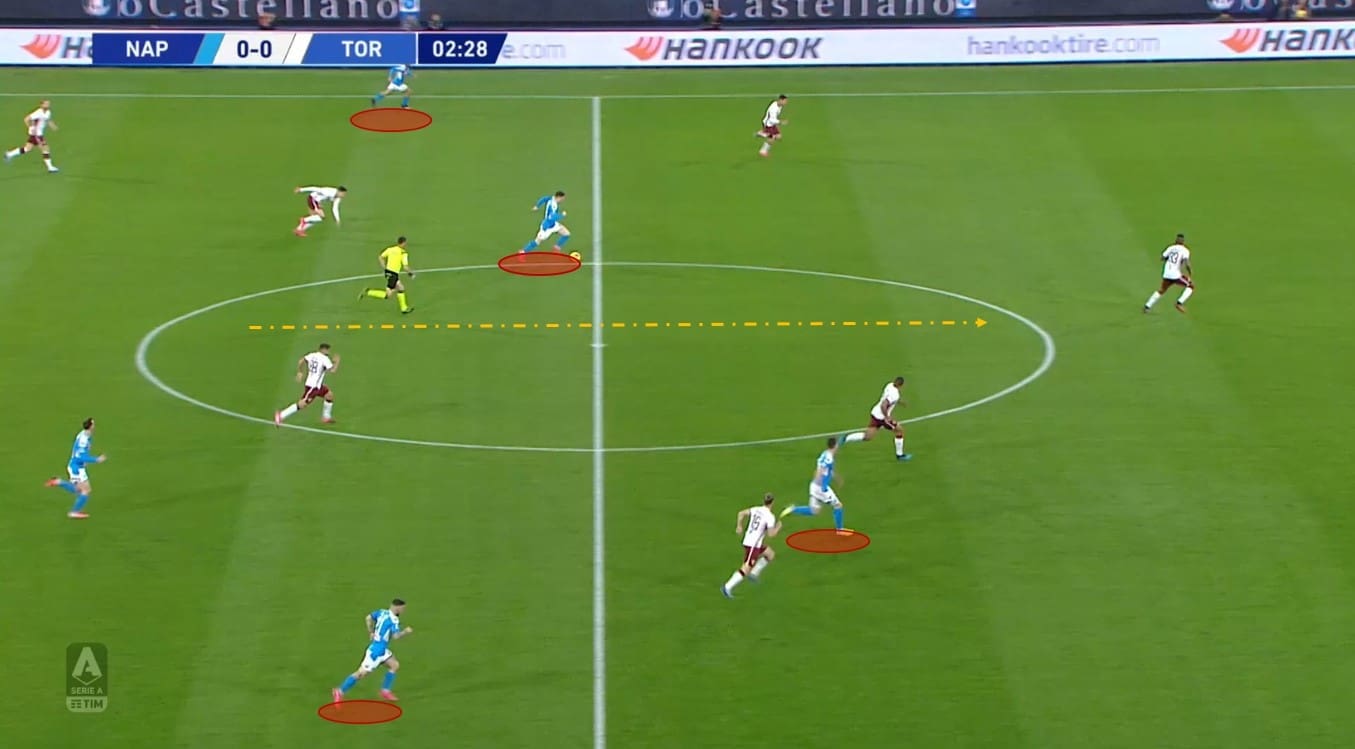
Finishing efforts
Many the times no matter how creative the teams are, they hardly manage to convert a high amount of their chances into goals. It’s not only important to have players that provide good balls but also attackers that have strong off the ball movement and technique to be able to take advantage of these balls.
Front players’ timely movement and decision-making are very important for the team’s attacking efforts. They need to move in sync with the ball carrier and make a good decision on how they should proceed after receiving the ball. This either involves direct shooting, or the ability to hold on to the ball under pressure and shoot from a better position.
That’s why we’ll look into their positioning in the box/ off the ball movement, but also their work under pressure and technique.
1. Off the ball movement and technique
As mentioned previously the front lines’ movement is very important for Napoli’s attacking actions. Most of Napoli’s attacking players have quite solid positional awareness and always try to spread around the penalty area in order to have more options for shots.
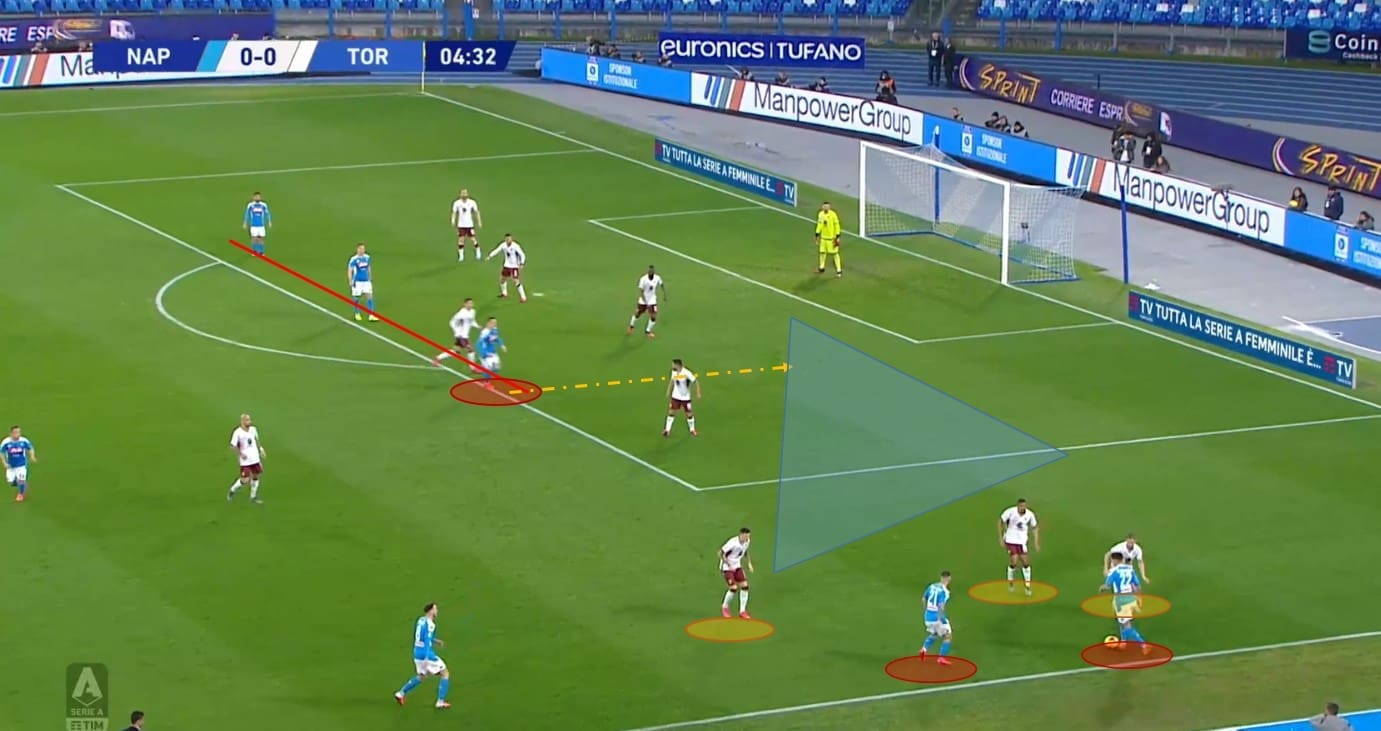
Both of the regular starters in the central forward position – Mertens and Milik rely a lot on their movement and positioning. Despite their role upfront, they are not limiting their movement only to the box, although their main responsibilities are creating goalscoring opportunities.
They both move smartly between the opposition players and while Milik has a better aerial contribution and serves as a more direct threat, Mertens’ movement is important for exploiting spaces both for shooting purposes but also for supporting other players’ actions.
Mertens often occupies the half-spaces in and out the box but his shooting efforts from these angles often end up unsuccessful. He also often relies on shots from distance, especially when their opponents have dropped deeper and there are fewer options to penetrate. These shots though also rarely end up on target. Methens control on the ball when receiving the ball often doesn’t meet the expectations in key areas, which is a result of poor work under pressure. That is not always the case, though, since he is strong when in possession and successfully holds on to the ball thanks to his dribbling abilities.
Milik on the other side positions in the central areas and is more often a threat in the box. Half of his efforts end up on target and his physicality is often crucial for taking control of the ball and shooting properly. He rarely shoots from distance, although many of his efforts from outside the box are accurate too.
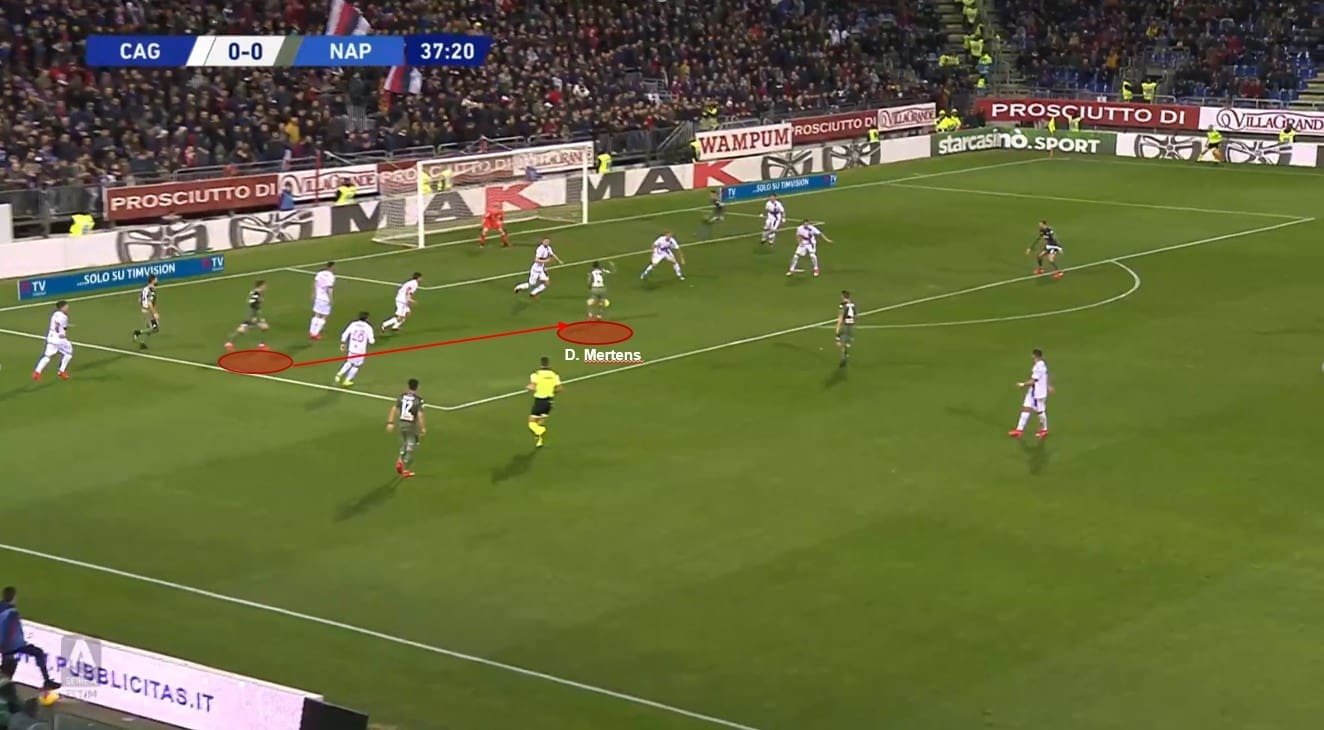
2. Options upfront
Their options in front of the goal are limited, although the wide players and the midfielders support with shooting efforts, Napoli do need more versatile player around the goal. Being strong under pressure and having solid spatial awareness is key for being successful there.
Perhaps, considering using Insigne as a second striker might be a good idea. Despite his role on the wing, he contributes with a high amount of shots on target from short and long-distance. Having all the other responsibilities of crossing, providing through balls and also dragging players out of position with his movement, can’t let him focus on his shooting although he could be extremely useful for scoring goals.
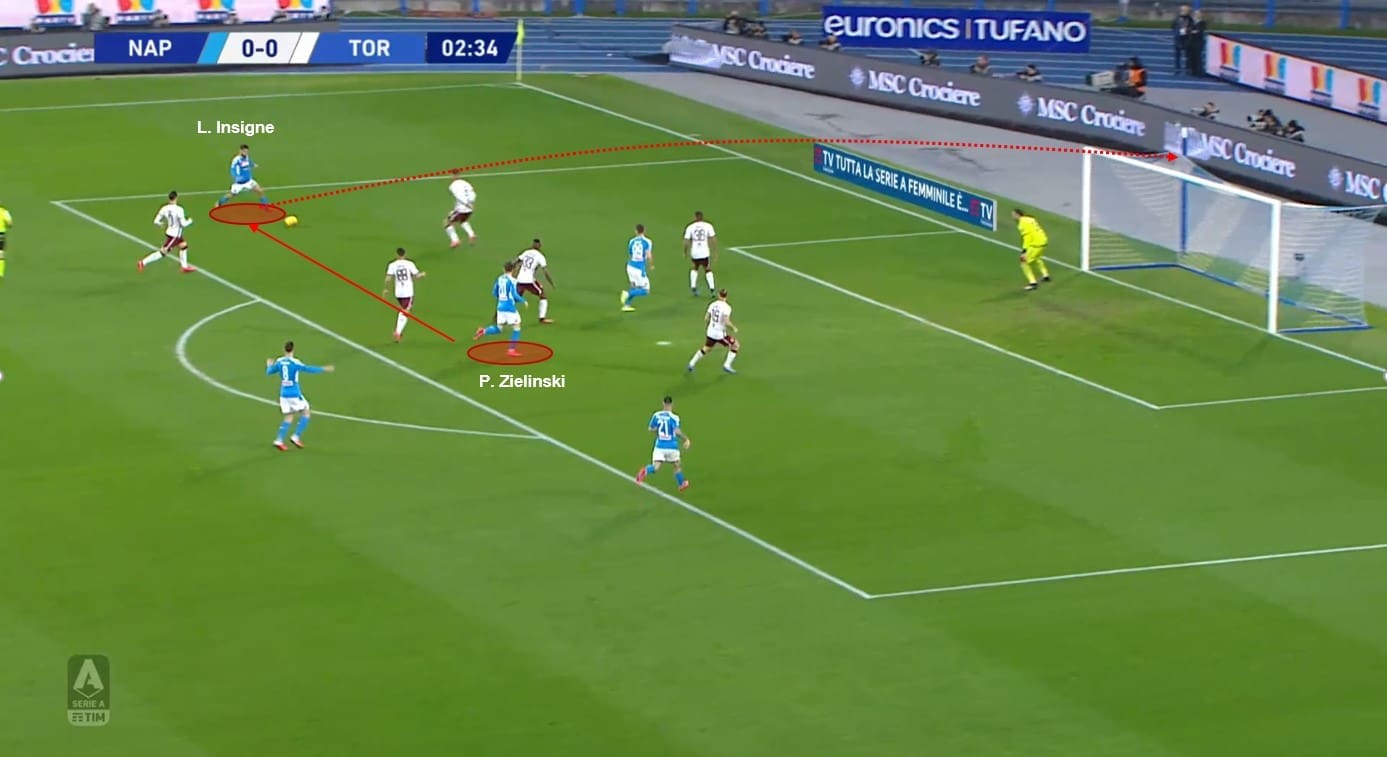
3. End product
Napoli have scored 41 goals in the league by now. Even though 40% of their shots come from outside the box, most of their successful efforts come from positions in the penalty area. They are underperforming their xG of 45.69 and can’t balance off their performance.
They put a lot of efforts into creating goal-scoring opportunities but their hasty actions sometimes take off of their efficiency. Providing a little fewer passes but using the time for improving their decision-making and delivery areas could improve their scoring record, although the real impact could come by considering recruitment in the central attacking positions.
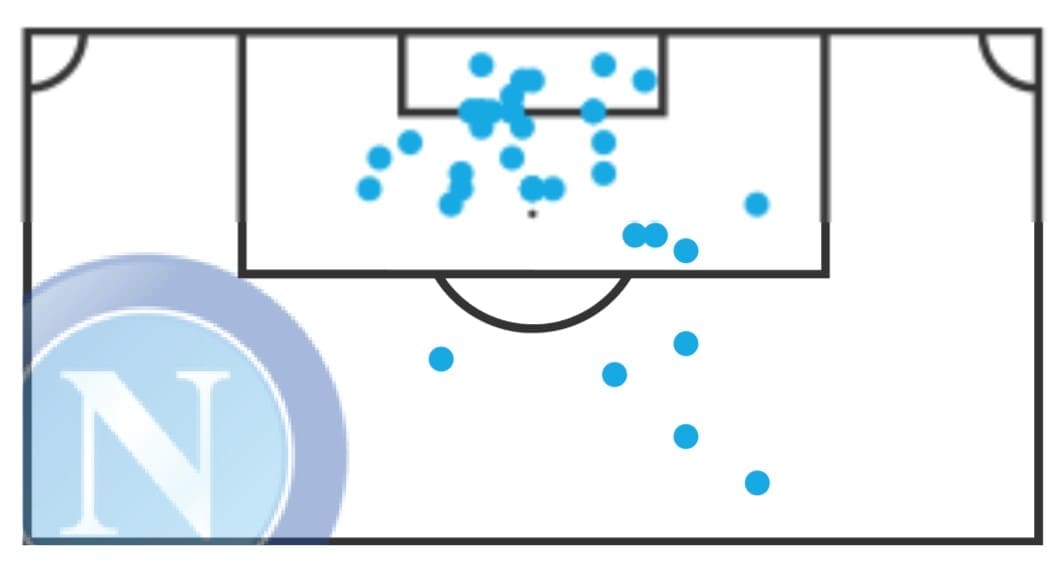
Conclusion
Napoli’s players are among the most creative in the league which is proven by their high amount of successful actions in the final third. Turning all their chances into goals though turns out harder than it seems, due to the lack of precision and strong work under pressure.
Although the deliveries towards the forwards could take some improvements, what really matters is having versatile players in the key areas that could finish off these chances. That’s why exploring some options on the transfer market could be a successful strategy to be able to reach the success of Juventus, Lazio and Inter in attack.





Comments